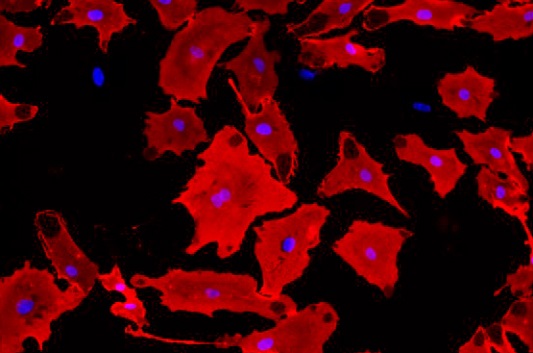Polish Study Finds That COVID-19 Stiffens Blood Vessel Cells and Disrupts Their Structure
Nikhil Prasad Fact checked by:Thailand Medical News Team Dec 01, 2024 11 months, 2 weeks, 1 day, 3 hours, 8 minutes ago
Medical News: COVID-19 has become infamous not only for its respiratory effects but also for the extensive systemic complications it triggers. A particular area of concern lies in the vascular system, as the disease has been linked to cardiovascular issues, clotting disorders, and chronic inflammation. Recent research conducted by a multidisciplinary team from Jagiellonian University, Kraków, Poland, sheds light on how the SARS-CoV-2 virus affects human endothelial cells - key components of blood vessel walls. These findings reveal crucial mechanisms by which COVID-19 may lead to vascular dysfunction, providing new insights into its severity and long-term impacts.
 Polish Study Finds That COVID-19 Stiffens Blood Vessel Cells and Disrupts Their Structure
The Central Role of Endothelial Cells in Vascular Health
Polish Study Finds That COVID-19 Stiffens Blood Vessel Cells and Disrupts Their Structure
The Central Role of Endothelial Cells in Vascular Health
Endothelial cells are specialized cells lining the interior of blood vessels. These cells are responsible for maintaining vascular integrity, flexibility, and responsiveness to blood flow. They also help prevent clot formation and regulate inflammation. Damage or dysfunction in these cells can lead to severe complications such as thrombosis, hypertension, and systemic inflammation, all of which are hallmarks of severe COVID-19.
The study covered in this
Medical News report focused on human pulmonary artery endothelial cells (HPAECs), a model system to study endothelial behavior, and compared them with A549 epithelial cells, which are known to support SARS-CoV-2 replication. Using state-of-the-art techniques, the researchers investigated how the virus interacts with endothelial cells and how this interaction alters their mechanical and structural properties.
Mechanisms of Endothelial Dysfunction Unveiled
The researchers observed significant changes in endothelial cells exposed to SARS-CoV-2. Unlike epithelial cells, where the virus actively replicates, endothelial cells experience what scientists call an “abortive infection.” The virus can enter these cells and initiate early replication processes, but it cannot complete its replication cycle. Despite this, the interaction leads to profound alterations in cellular behavior and structure.
Key Findings in Detail
-Loss of Elasticity
Endothelial cells infected with SARS-CoV-2 exhibited a marked reduction in elasticity, a crucial property that allows these cells to respond dynamically to changes in blood flow and pressure. The loss of elasticity is attributed to changes in the cellular cytoskeleton, specifically the actin filaments. A stiffened endothelium contributes to impaired blood flow regulation, which could exacerbate conditions such as hypertension and increase the risk of vascular injury.
-Cytoskeleton Remodeling and Cellular Structure
The study demonstrated extensive remodeling of the actin cytoskeleton in endothelial cells. Actin filaments are essential for maintaining cell shape, mechanical stability, and intracellular t
ransport. SARS-CoV-2 induced polymerization of these filaments, causing cells to become stiffer and lose their ability to maintain proper intercellular connections. This remodeling was linked to the formation of gaps between cells, increasing endothelial permeability - a condition that can facilitate leakage of plasma components and infiltration of inflammatory cells.
-Increased Inflammation and Loss of Protective Layers
The infected endothelial cells showed elevated levels of inflammatory markers such as ICAM-1, which promotes the adhesion of white blood cells to the endothelium, exacerbating inflammation. Additionally, there was a reduction in the glycocalyx, a sugar-rich protective layer that normally prevents excessive cell adhesion and clotting. The loss of glycocalyx integrity not only promotes inflammation but also increases susceptibility to thrombosis.
-Variants of SARS-CoV-2 and Their Effects on Endothelial Cells
The study explored the effects of different SARS-CoV-2 variants, including the original Wuhan strain and the Alpha, Beta, and Delta variants. All variants caused similar cellular changes, but the magnitude of these effects varied. The Delta variant was particularly disruptive, causing the most significant loss of elasticity and structural changes. These differences may partially explain the variant-specific differences in disease severity and transmission rates observed clinically.
The Broader Implications of Endothelial Dysfunction in COVID-19
The findings highlight the central role of endothelial dysfunction in severe COVID-19. The direct impact of SARS-CoV-2 on endothelial cells disrupts their normal functions, leading to a cascade of vascular complications. Increased stiffness, inflammation, and permeability in blood vessels create a pro-thrombotic and pro-inflammatory environment, which can lead to widespread organ damage.
Linking Cellular Changes to Clinical Outcomes
The study also provides an explanation for why some COVID-19 patients experience severe cardiovascular and thrombotic complications. By altering endothelial elasticity and promoting inflammation, the virus undermines the body’s vascular defense mechanisms. This process may contribute to conditions such as deep vein thrombosis, pulmonary embolism, and even strokes observed in COVID-19 patients.
Conclusions and Future Directions
The research from Jagiellonian University underscores the complexity of COVID-19 as a systemic disease that extends beyond the lungs to the vascular system. By showing that SARS-CoV-2 directly alters the mechanical properties of endothelial cells, the study provides new insights into the mechanisms driving severe COVID-19 and its complications.
These findings open the door to potential therapeutic interventions aimed at protecting endothelial function. For example, drugs targeting the actin cytoskeleton or enhancing glycocalyx integrity might mitigate some of the vascular damage caused by the virus. Additionally, understanding the variant-specific effects on endothelial cells can inform public health strategies and clinical management of COVID-19.
Looking ahead, further research is needed to explore how these cellular changes translate to long-term complications in COVID-19 survivors, particularly those suffering from long COVID. Understanding the interplay between viral interactions and endothelial biology could also lead to broader insights into other viral infections and their systemic impacts.
The study findings were published in the peer-reviewed journal: Scientific Reports.
https://link.springer.com/article/10.1038/s41598-024-80351-z
For the latest COVID-19 News, keep on logging to Thailand
Medical News.
Read Also:
https://www.thailandmedical.news/news/covid-19-causes-upregulation-of-vimentin-expression-and-reduced-n-cadherin-expression
https://www.thailandmedical.news/news/covid-19-can-cause-cervical-arterial-dissections-or-tears-in-the-wall-of-the-large-blood-vessel-in-the-neck
https://www.thailandmedical.news/news/doctors-warn-of-hidden-threat-of-covid-19-involving-portal-vein-thrombosis
https://www.thailandmedical.news/news/persistent-endothelial-dysfunction-oxidative-stress-and-lipid-peroxidation-are-found-in-women-with-post-covid-19-health-issues
